Note: Measurements taken in the anechoic chamber at Canada's National Research Council can be found through this link.
 GoldenEar Technology’s Triton Reference was never meant to be. At the 2014 Consumer Electronics Show, Sandy Gross, who cofounded GoldenEar with engineer Don Givogue, told me that the Triton One ($4999.98 USD per pair) he was then demonstrating was the biggest, most expensive loudspeaker his company would ever make. (I reviewed the Triton One for this site in April 2015.) But, as Gross later told me, as soon as the Triton One was released, people began asking for more speaker -- and at a higher price. As well versed as Gross is in the speaker business -- before GoldenEar, he cofounded Polk Audio with Matthew Polk, and, with Givogue, Definitive Technology -- he’d never anticipated that kind of pressure. He thought he should do something about it.
GoldenEar Technology’s Triton Reference was never meant to be. At the 2014 Consumer Electronics Show, Sandy Gross, who cofounded GoldenEar with engineer Don Givogue, told me that the Triton One ($4999.98 USD per pair) he was then demonstrating was the biggest, most expensive loudspeaker his company would ever make. (I reviewed the Triton One for this site in April 2015.) But, as Gross later told me, as soon as the Triton One was released, people began asking for more speaker -- and at a higher price. As well versed as Gross is in the speaker business -- before GoldenEar, he cofounded Polk Audio with Matthew Polk, and, with Givogue, Definitive Technology -- he’d never anticipated that kind of pressure. He thought he should do something about it.
But GoldenEar’s model-naming scheme presented a bit of a problem: typically, the lower its number, the higher in the line that model is in terms of price and, typically, cabinet size, driver count, and parts quality. Logically, the next model up would be named the Triton Zero or 0.5 -- but neither sounded good for a flagship speaker priced at $8499.98/pair. They called it the Triton Reference.
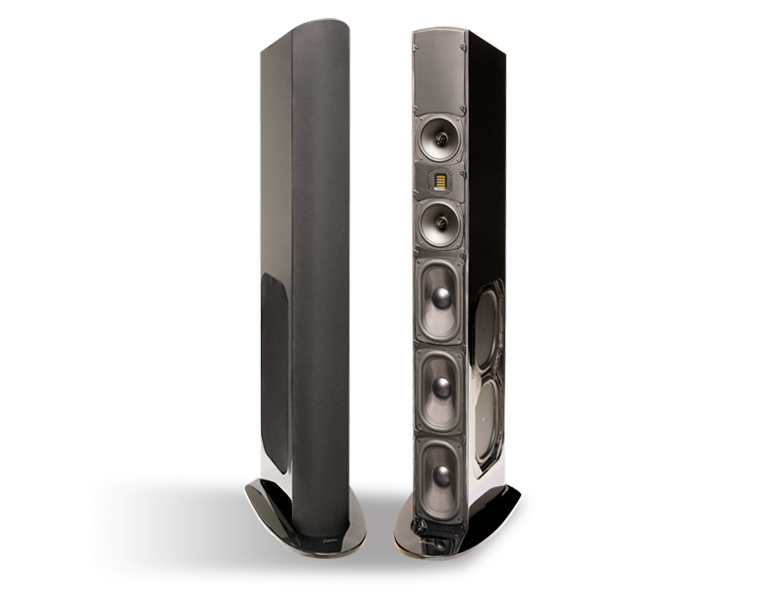
Description
I’d thought the 54”-high Triton One was big when I set up a pair of them in my room, but the Triton Reference’s main cabinet is 4” taller, 1.25” wider, 2” deeper, and a lot heavier: 108 pounds vs. the One’s 73 pounds. The increase in weight has to do with a larger, beefier, better-braced cabinet; bigger drivers with more robust motors; and a sturdier plinth that measures 13.63”W x 22.25”D. Like the plinth of the One and other Triton models, this one is made of Medite, a medium-density fiberboard, but for the Reference a 0.094”-thick steel plate has been added. Rubber feet and floor spikes are included. I have carpet, so I used the spikes.
The Triton Reference also boasts a touch of elegance not found on previous GoldenEar towers: instead of a “sock” of black fabric covering all but the small top panel, the Reference’s sides, rear, and top are finished in a polished, piano-black lacquer. Cloth is used only on the front, to cover the metal grille that protects the drivers, and on the lower part of the side panels, to cover the passive radiators. Although I got used to the look of the One and other Tritons, the Reference’s high-gloss lacquer looks a lot nicer to me, and befits a speaker at this higher price. I also like the way the side and rear panels form one seamless piece with the top; on the lower-priced towers, the sock is topped off with a shiny snap-on cap.
The One and the Reference are both three-way designs with the same general driver configuration: four passive radiators, three woofers, two midranges, and one tweeter. However, the drivers themselves are different. GoldenEar doesn’t specify their speakers’ crossover frequencies, but Gross told me that the Reference’s woofers hand off to its midranges at 90Hz, and the mids to the tweeter at 3kHz.
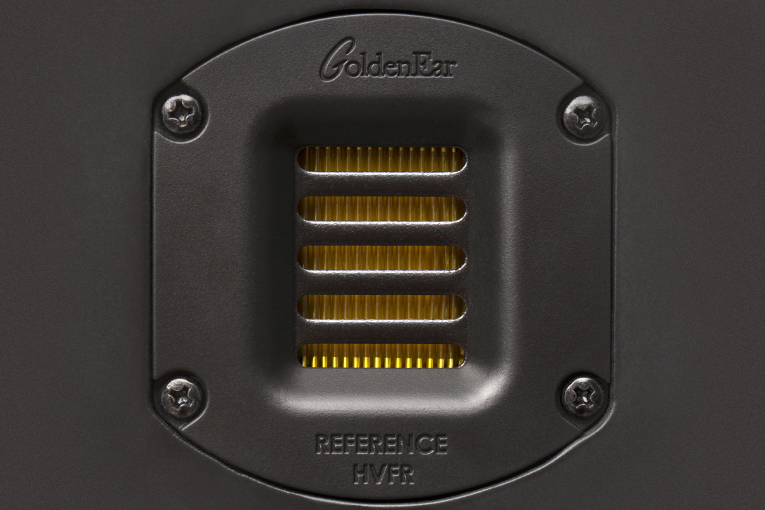
The most notable driver in the Triton Reference is GoldenEar’s new Reference High-Velocity Folded-Ribbon (RHVFR) tweeter, which differs from the High-Velocity Folded-Ribbon (HVFR) tweeters used in all other Triton models, and whose magnets are claimed to include 50% more neodymium than in the HVFRs, for better transient response and higher efficiency. This should mean that the Reference can reproduce high frequencies louder with less power, less heat buildup, and lower distortion.
The two new 6” midranges are placed above and below the tweeter. They have baskets of cast aluminum, for strength and to reduce resonance and ringing, and, per GoldenEar, have “a newly developed cone with unique low-mass bonding to the butyl rubber surround for improved transient response.” The midrange also features GoldenEar’s new Focused Field magnet system, which the company claims “better directs the magnet flux to the voice coil gap,” for, again, higher efficiency.
GoldenEar’s designers have always sought to achieve the deepest possible bass extension from their speakers, which is why they call the bass sections of their speakers subwoofers, and liberally use passive low-end radiators. Like ports, passive radiators are tuned to certain frequencies and are activated by the motion of the powered woofer or woofers; they’re not connected to an amplifier. A passive radiator, properly designed, increases a speaker’s bass output above what the woofer(s) alone could produce, and also extends it lower. The Triton Reference’s three quadratic (i.e., racetrack-shaped) woofers, each measuring 10”L x 6”W, are mounted on the lower half of the baffle and fire in unison, powered by a built-in 1800W amplifier. A 56-bit digital signal-processing (DSP) engine is used to extend and linearize the response, its output level controlled with the Subwoofer Level dial on the rear panel, near the binding posts. This dial has the usual range of settings from Min to Max, with the “flat” or midpoint precisely between them, and straight up at 12 o’clock. The amplifier automatically turns itself on when it detects an incoming signal, then turns itself off when no signal has been present for about ten minutes.
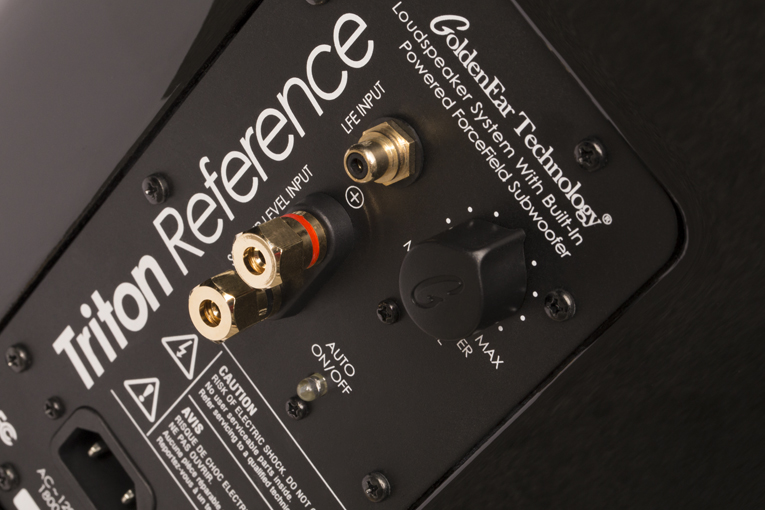
The four passive radiators each measure 10.5”L x 9.5”W, and are mounted in horizontally opposed pairs (GoldenEar describes them as “inertially balanced”) on the bottom halves of the cabinet’s side panels, two per side. This opposition permits the equal and opposite forces to help cancel out vibrations that would otherwise enter into and likely radiate out through the cabinet. This benefit is offered by other speakers with side-mounted woofers, such as KEF’s Blade Two ($24,999.99/pair) and Devialet’s Gold Phantom ($5980/pair), both of which I’ve reviewed.
The Triton Reference’s three woofers and four passive radiators provide a tremendous amount of bass-radiating area. GoldenEar specifies the speaker’s frequency range as 12Hz-35kHz, though its actual output at the low end is unspecified, probably because you can adjust the bass section’s output level. Because the bass section is self-powered, your power amplifier will drive only the midranges and tweeters, so it faces a lighter workload. Other specs: The Reference’s overall sensitivity is 93.25dB (2.83V/m), which is very high, and its modest nominal impedance is “compatible with 8 ohms,” which explains the minimum power rating of just 20W. The range of recommended amplification actually goes all the way up to 750W, but I doubt you’d ever need that much power.
The References sounded their best when driven with a pair of Constellation Audio Revelation Taurus Mono monoblocks (in for review), which have a claimed output into 8 ohms of 500W each. That wasn’t because of the Tauruses’ super-high power output, which I never came close to tapping -- they just sounded better than the Eximus S1 stereo amp I also used. But even the S1’s modest specified power output of 125Wpc into 8 ohms was more than enough to drive the References to high volumes. The only amps I was able to push into clipping with the References were JE Audio’s VM60s -- tubed monoblocks that output 60W into 8 or 4 ohms. The VM60s worked well at typical listening levels, but couldn’t drive the GoldenEars as loudly as the other amps could. More on the subtle sonic differences among these amps below.
Setup
Although I tried different amps with the References, the rest of my system remained constant: a Samsung laptop running Roon and Tidal, connected by an AudioQuest Diamond USB cable to an EMM Labs DA2 Reference digital-to-analog converter, in turn connected via Crystal Cable CrystalConnect Standard Diamond balanced interconnects to a Constellation Audio Revelation Pictor preamplifier, which fed the power amps via Audience Au24 SX balanced interconnects. Siltech Classic Anniversary 330L speaker cables connected speakers to amps, and a variety of Shunyata Research power cables and power distributors were used for the electronics. The GoldenEars were plugged into a Shunyata distributor with Blue Circle Audio power cords.
Although the References are very large speakers, setting them up was a snap. I put them where I usually place speakers: 8’ apart, and each about 8’ from my listening chair, which allowed 5’ to the sidewalls and 6’ to the front wall. Toe-in was very slight: five degrees. As long as the recordings themselves had plenty of stereo information, these positions provided expansive soundstages with tight center focus. The Triton References’ Subwoofer Level dials were set to 12 o’clock, or flat, which delivered super-deep bass that never overloaded the room or obscured the mids and highs.
Sound
Glen Hansard’s Rhythm and Repose (Epitaph/Anti- 87203), a welcome recent addition to my review queue, is streamable from Tidal in 16-bit/44.1kHz FLAC or 24/48 MQA (which Tidal unfolds to 24/96). The first track, “You Will Become,” showed off the Triton References’ many strengths, especially at the 2:43 mark, when some really deep bass frequencies enter. The References filled my room with astoundingly deep bass that, to the best of my aural memory, didn’t necessarily sound any deeper than the Ones had produced here -- they, too, went super-deep -- but was definitely tighter, more detailed, and more textured. In sum, the One’s bass now sounded plodding in comparison to the Reference’s. This increased control and articulation also made for a seamless blend of the outputs of the seven drive units reproducing the bass and the two drivers handling the midrange; nothing in the sound indicated to me where the woofers and midranges were crossed over to each other. I also liked that, even with that ultradeep bass enveloping the front of the room, Hansard’s voice and guitar weren’t obscured in the slightest, but were reproduced extremely clearly, with plenty of detail, and with sharp image focus.
To get another perspective on the Triton Reference’s bass, I turned to a recording I’ve used in my reviews for decades: the Cowboy Junkies’ The Trinity Session (16/44.1 FLAC, RCA). I played digital files ripped from my Canadian-pressed CD, which has more deep bass and greater clarity than the Tidal version. “Mining for Gold” engulfed the speaker end of my room in what seemed an enormous space, with depth that went way past the front wall, while cleanly reproducing Margo Timmins’s voice as a solidly placed center image. “Misguided Angel” also laid out a beautiful stage in my room, with fine delineation of the musicians’ positions across the width of the stage and from front to back -- the position of each was easy to “see.” I can’t say that the stages were larger than I recall hearing from the Ones, or the images more precise, but neither was diminished in any way. This was a good thing -- I’d feared that, with bigger cabinets, and bigger drivers spaced farther apart, the soundstaging and imaging might suffer. It didn’t.
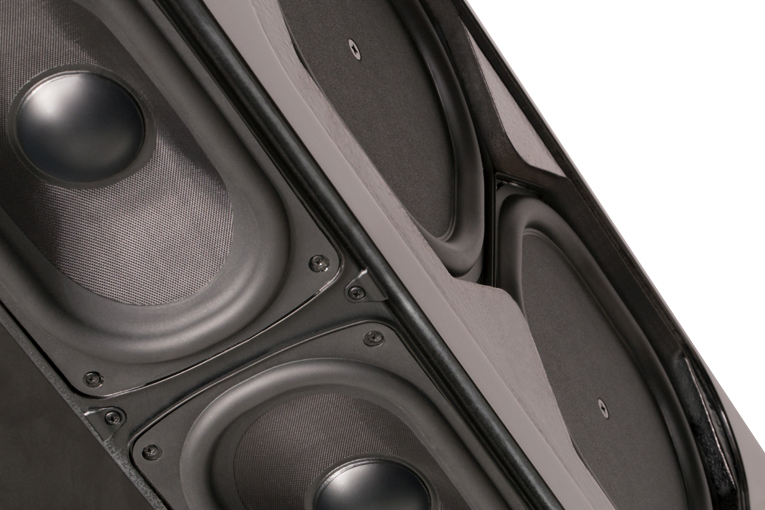
In most tracks of Trinity Session the bass goes down to 20Hz, and the Triton References reproduced the awesome glory of every note with full weight and a lot of texture. The result was music that I felt even more than I did when listening to it through the Ones. I could sense the air in the room swell with each song, and could imagine that if the walls were made of rubber, they’d be flexing outward and inward in time with the music. But, as with the Glen Hansard album, all that bass didn’t overshadow the frequencies above it -- I had no problem hearing voices, and the instruments that live in the mids and highs.
In my review last month of Devialet’s amazing Gold Phantom, I wrote about how they could play extraordinarily deep in the bass -- right down to 20Hz. But they didn’t make me feel as immersed in the space of the recording venue as fully as the References did -- that pressurizing of the room I talked about in the preceding paragraph. For the tracks mentioned so far, the only speakers that have reproduced them as authoritatively and with as much control in my room have been the KEF Blade Twos, which puts the References in good company indeed. The Reference wasn’t the be-all, end-all for bass -- the Blade Two, though it didn’t go any deeper, still sounded a little punchier and more forceful in my room. Still, that’s very good for a speaker that costs about one-third as much as the Blade Two.
The way the References reproduced Hansard’s voice in “Bird of Sorrow,” from Rhythm and Repose, reminded me of what I’ve heard through some of the finest speakers I’ve listened to. It was detailed, yet so smooth as to sound slightly liquid, which gave it an ease that made it more realistic and entirely nonfatiguing. Similarly, when I listened to “Spanish Steps,” from my current favorite Van Morrison album, Poetic Champions Compose (16/44.1 FLAC, Mercury/Tidal), I marveled at the sound of Morrison’s alto sax, which combined raw force, exquisite detail, and texture with a smoothness that kept it from sounding strident. This combination of exceptional smoothness and high detail came out most when I powered the References with the JE Audio VM60s or Constellation Revelation Taurus Monos, both of which have a fuller, silkier midrange than the Eximus S1. To quote Sade, the Reference One is one smooth operator -- but not so smooth as to lack resolution or gloss over details.
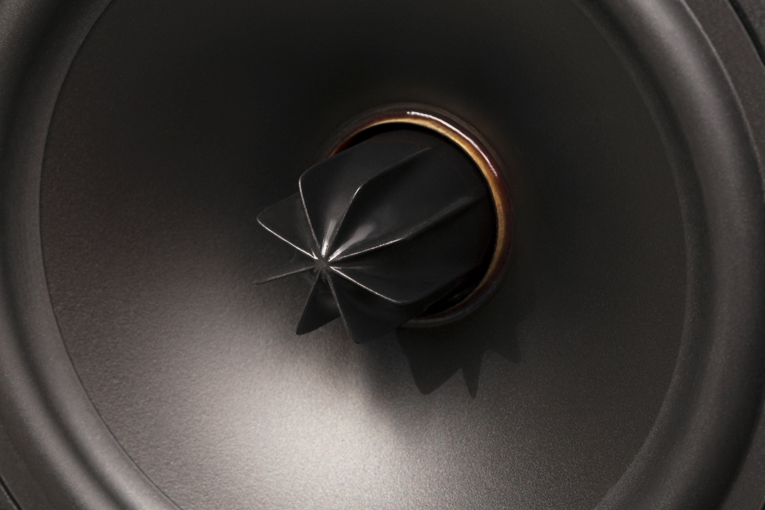
As I wrote in my review of the Triton One: “When I pushed the Ones very hard -- to levels I wouldn’t recommend anyone listen to for any length of time -- I didn’t damage the drivers or cause them to distort in any objectionable way (e.g., funny noises, grungy sound, etc.), but I did notice that the midrange and highs compressed. I also heard a resonant character in the midrange that might have been the drivers or the cabinet, or both -- it was too loud to be sure.”
The Triton References were a different story. When I used the big Constellation monos to play “You Shook Me All Night Long,” from AC/DC’s Back in Black (16/44.1 FLAC, Atlantic/Tidal), and “Roller,” from April Wine’s First Glance (16/44.1 FLAC, Aquarius/Capitol/Tidal), at volume levels that made my ears ring, I heard no resonant character in the midrange drivers or from the cabinet, and the highs remained lively and clean. The References weren’t quite as effortless as the Blade Twos at similar SPLs -- as far as I dared to push them, the Twos just kept going -- but at these high volumes they played considerably louder without audibly compressing than the Ones did. It appears that the Reference’s new tweeter and midranges can better handle this kind of abuse.
At more typical listening levels, the improvements in the mids and the highs revealed themselves readily when I played any good recording of acoustic piano. Hammer strokes sounded purer and more deliberate than I recall from the One -- I was consistently drawn to the clarity and consistency of the References’ reproduction of pianos. In “Spanish Steps,” for example, it was always Morrison’s sax that drew most of my attention, but through the References, Neil Drinkwater’s piano held my focus just as much. The sound of cymbal crashes was also improved, in terms not only of cleanness but of liveliness -- through the References, the highs were just a little more immediate, precise, and unrestrained.
It was much the same with acoustic guitar. In “Pacing the Cage” and “Mistress of Storms,” from Bruce Cockburn’s The Charity of Night (16/44.1 FLAC, True North/Tidal), the clean, spirited sound of his guitar left no doubt in my mind that the Triton Reference is now the most exciting GoldenEar speaker to listen to. Through it, music sounded most alive, with a jump factor I don’t recall hearing with the One. “More incisive” is the phrase that kept coming to mind. Cockburn’s close-miked voice in “Pacing the Cage” showed off the GoldenEar’s aforementioned balance of detail and smoothness than well as a complete lack of coloration -- it sounded real. This was even more apparent four tracks later, in “Birmingham Shadows,” in which Cockburn speaks more than sings. Having seen Cockburn in concert often over the last 37 years, I can attest that, through the References, his voice sounded entirely believable. This might be the liveliest-sounding speaker that GoldenEar Technology has produced, but it didn’t depart from neutrality.

I loved the way the References reproduced women’s voices. They inspired me to dig out a recording I hadn’t heard in a long time: Whitney Houston’s cover of Dolly Parton’s “I Will Always Love You,” from the soundtrack album for the film The Bodyguard (16/44.1 FLAC, Arista/Tidal). I bought the CD when it was first released, in 1992, have played this track with most of my systems over the years, and have always marveled at how beautiful her voice sounds and how powerfully it can be projected through a good system. (Although it now seems common knowledge, I just learned that it was Whitney’s costar Kevin Costner who suggested that she sing the opening unaccompanied. I read it online, but it was revealed in the documentary Whitney: Can I Be Me.) While I was tempted to really crank up the volume, I didn’t. Instead, I played the track at a moderate volume level, and reveled in how powerful it sounded, mostly because of how cleanly it was being sung. The purity of Houston’s voice was captivating through the References -- among the very best I’ve heard. Then the band enters with aplomb, the Reference conveying the full weight and spreading a stage from here to there. It was the kind of room-filling, full-range sound you expect to pay a lot more for.
Conclusion
GoldenEar Technology’s Triton Reference costs 70% more than their Triton One, and for significantly more money you get significantly more. GoldenEar has created a speaker that’s not only bigger than the One, but better in many ways. The improvements in build and sound quality are dramatic.
With its metal-loaded plinth and sturdier, more robustly braced cabinet, the Triton Reference is built better than any other GoldenEar. I also prefer its looks, mostly for the move from a fabric sock to a piano-black lacquer. Most important, the Reference sounds better across the board than even the One. In some ways -- the greater clarity and ease throughout the midrange -- the improvement is small. But the resolution of detail, the bass articulation, the treble, and the clarity at high volumes are all greatly improved. Nor does the Reference’s larger size mean that it gives up to the One anything in soundstaging and imaging.
Almost everything the One does well the Reference does better. This makes it, to my eyes and ears, not only the superior speaker, but the one I’d recommend to anyone whose budget stretches as far as $8500 -- although not cheap, the Reference can easily be compared to speakers from other brands costing considerably more. It may be that the Triton Reference was never meant to be, but in GoldenEar Technology’s formidable product line it’s now the one to beat. I wonder -- with this success, will they be tempted to go even higher?
. . . Doug Schneider
das@soundstagenetwork.com
Associated Equipment
- Speakers -- Devialet Gold Phantom, Dynaudio Special Forty
- Preamplifier -- Constellation Audio Revelation Pictor
- Power amplifiers -- Constellation Audio Revelation Taurus Mono (monoblocks), Eximus S1, JE Audio VM60 (monoblocks)
- Digital-to-analog converter -- EMM Labs DA2 Reference
- Computer -- Samsung laptop running Windows 10, JRiver Media Center 20, Roon, Tidal
- Digital interconnect -- AudioQuest Diamond USB
- Analog interconnects -- Audience Au24 SX, Crystal Cable CrystalConnect Standard Diamond
- Speaker cables -- Siltech Classic Anniversary 330L
- Power cords -- Blue Circle Audio, Shunyata Research Venom HC
- Power distributor/conditioner -- Shunyata Research Venom PS8 with Defender (2)
GoldenEar Technology Triton Reference Loudspeakers
Price: $8499.98 USD per pair.
Warranty, parts and labor: five years, drivers and cabinets; three years, electronics.
GoldenEar Technology
PO Box 141
Stevenson, MD 21153
Phone: (410) 998-9134
Fax: (410) 356-0808
Website: www.goldenear.com






















